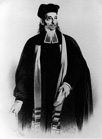 Isaac Noah Mannheimer was born and raised in Copenhagen, Denmark. He studied at the Copenhagen University and, concurrently, concentrated on Jewish studies. The Danish government appointed him head teacher of religion after he introduced the reform in Jewish religion instruction (1816). His main work was preparing and examining students for confirmation. The first ceremony was held in presence of high officials of the government and accompanied with organ music (1817). He gave lectures and preached in the Danish language. Between 1821 and 1823, he worked in different towns where he helped to establish reform rituals. In 1824, he left Copenhagen for Vienna where he officiated at the new Seitenstetten Synagogue. The religious school council named him as headmaster. Mannheimer was known as one of the leading preachers of the 19th century, attracting many segments of the Jewish population. This was especially important since Jews could not live as a community at that time. In his sermons, which were inspirational more than teaching, he used the aggadah but translated it in modern terms. In later years, Mannheimer found a middle course between the orthodox way and the radical reform of conducting services, by eliminating some traditions without destroying their essence. The prayers were conducted in Hebrew. Organ music was not used and the prayers of Zion and Jerusalem were retained. He defended circumcision as a basic ritual of the Jewish religion. His new way was called “worship according to Mannheimer”. This prevented a split in the Jewish community in Austria, Hungary and Bohemia. Mannheimer was also active in Jewish social community and with others achieved the abolishment of the “more Judaico” oath. He prevented the limitation of the number of Jewish medical students, proposed by Professor Rosas (1842). In 1848 he published a Declaration on the Jewish Problem and sent a draft law to the political commission. He was elected to the Reichstag, where, with others, succeeded in removal of the “Jewish Tax”. He pleaded for abolishing the death penalty and was active in Liberal ideas. This brought him into a clash with the Jewish Viennese community and forced him to resign from political life. He opposed demanding emancipation by the Jews and thought that it should come from the non-Jews. Mannheimer was active in literary work and wrote German translations to the prayer book and festival prayers. A number of his sermons have been published.
Isaac Noah Mannheimer was born and raised in Copenhagen, Denmark. He studied at the Copenhagen University and, concurrently, concentrated on Jewish studies. The Danish government appointed him head teacher of religion after he introduced the reform in Jewish religion instruction (1816). His main work was preparing and examining students for confirmation. The first ceremony was held in presence of high officials of the government and accompanied with organ music (1817). He gave lectures and preached in the Danish language. Between 1821 and 1823, he worked in different towns where he helped to establish reform rituals. In 1824, he left Copenhagen for Vienna where he officiated at the new Seitenstetten Synagogue. The religious school council named him as headmaster. Mannheimer was known as one of the leading preachers of the 19th century, attracting many segments of the Jewish population. This was especially important since Jews could not live as a community at that time. In his sermons, which were inspirational more than teaching, he used the aggadah but translated it in modern terms. In later years, Mannheimer found a middle course between the orthodox way and the radical reform of conducting services, by eliminating some traditions without destroying their essence. The prayers were conducted in Hebrew. Organ music was not used and the prayers of Zion and Jerusalem were retained. He defended circumcision as a basic ritual of the Jewish religion. His new way was called “worship according to Mannheimer”. This prevented a split in the Jewish community in Austria, Hungary and Bohemia. Mannheimer was also active in Jewish social community and with others achieved the abolishment of the “more Judaico” oath. He prevented the limitation of the number of Jewish medical students, proposed by Professor Rosas (1842). In 1848 he published a Declaration on the Jewish Problem and sent a draft law to the political commission. He was elected to the Reichstag, where, with others, succeeded in removal of the “Jewish Tax”. He pleaded for abolishing the death penalty and was active in Liberal ideas. This brought him into a clash with the Jewish Viennese community and forced him to resign from political life. He opposed demanding emancipation by the Jews and thought that it should come from the non-Jews. Mannheimer was active in literary work and wrote German translations to the prayer book and festival prayers. A number of his sermons have been published.